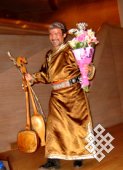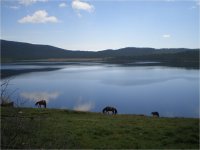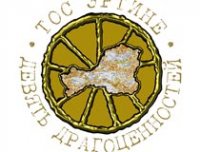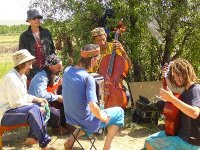| | | |
Archive
| « December 2025 » |
|---|
| Mo | Tu | We | Th | Fr | Sa | Su |
|---|
| 1 | 2 | 3 | 4 | 5 | 6 | 7 | | 8 | 9 | 10 | 11 | 12 | 13 | 14 | | 15 | 16 | 17 | 18 | 19 | 20 | 21 | | 22 | 23 | 24 | 25 | 26 | 27 | 28 | | 29 | 30 | 31 | |
|
| | | |
|
|
|
|
|
|
|
1 September 2010 | Views: 7784 | Comments: 0 |
|
|
 On the day of the Republic, August 15 in the morning, in the hall of the National Museum of RT, a “round table” conference “Tradition and today in the artistic use of felt” took place. It was a meeting of enthusiastic people; who came not just from Tuva, but also from various regions of Russia. They were all united by by love of this amazing material which came to the 21st century from the depths of history. If you ask an average young city dweller what objects made of felt he can think of, expect a short answer – felt boots and house slippers, and that only in the best case. But this undeservedly almost forgotten woolen material is now coming out of the shadow of oblivion, and is becoming again attractive to artists, artisans and craftsmen. On the day of the Republic, August 15 in the morning, in the hall of the National Museum of RT, a “round table” conference “Tradition and today in the artistic use of felt” took place. It was a meeting of enthusiastic people; who came not just from Tuva, but also from various regions of Russia. They were all united by by love of this amazing material which came to the 21st century from the depths of history. If you ask an average young city dweller what objects made of felt he can think of, expect a short answer – felt boots and house slippers, and that only in the best case. But this undeservedly almost forgotten woolen material is now coming out of the shadow of oblivion, and is becoming again attractive to artists, artisans and craftsmen.
|
|
|
|
|
|
Marina Kenin-Lopsan, Tuvinskaya Pravda, tuva.asia, translated by Heda Jindrak |
|
|
|
|
|
|
|
|
24 August 2010 | Views: 3717 | Comments: 0 |
|
|
 The next trip of the “Nine Treasures of Tuva” project is to the settlement Seserlig of the Pii-Khem district. Specifically, we are going to the place named Ush Kozhee (Three standing stones), to visit the three nomads incarnated in stone, who are protecting their territory to this day. The three stelae from Early Scythian times, located in a small valley rimmed with mountains, still show depictions of chains, rings, and belts with daggers. Their faces are practically faded. Obviously, they are warriors. The next trip of the “Nine Treasures of Tuva” project is to the settlement Seserlig of the Pii-Khem district. Specifically, we are going to the place named Ush Kozhee (Three standing stones), to visit the three nomads incarnated in stone, who are protecting their territory to this day. The three stelae from Early Scythian times, located in a small valley rimmed with mountains, still show depictions of chains, rings, and belts with daggers. Their faces are practically faded. Obviously, they are warriors.
|
|
|
|
|
|
Inna Printseva, TosErtine.tuva.ru, translated by Heda Jindrak |
|
|
|
|
|
|
|
|
20 August 2010 | Views: 4743 | Comments: 0 |
|
|
 Today, national khoomeizhi Khaigal-ool Khovalyg, solist of the Huun-Huur-Tu ensemble torns 50. He has been described as the “engine driver” when the American musicologist Ted Levin, comparing “Huun-Huur-Tu” to a train, evaluated the different functions of the musicians in the group. He is a native of one of the most “musical” places of Tuva – Dzun-Khemchik sovkhoz “Iskra” ( many other khoomeizhis are from this place, including Oleg Kuular of “Shu-de”). Kaigal-ool started his professional career in 1979 as a member of vocal-instrumental ensemble “Ayan”; in those years, the artistic programs for this ensemble were prepared in Leningrad. Today, national khoomeizhi Khaigal-ool Khovalyg, solist of the Huun-Huur-Tu ensemble torns 50. He has been described as the “engine driver” when the American musicologist Ted Levin, comparing “Huun-Huur-Tu” to a train, evaluated the different functions of the musicians in the group. He is a native of one of the most “musical” places of Tuva – Dzun-Khemchik sovkhoz “Iskra” ( many other khoomeizhis are from this place, including Oleg Kuular of “Shu-de”). Kaigal-ool started his professional career in 1979 as a member of vocal-instrumental ensemble “Ayan”; in those years, the artistic programs for this ensemble were prepared in Leningrad.
|
|
|
|
|
|
Dina Oyun, translated by Heda Jindrak |
|
|
|
|
|
|
|
|
20 August 2010 | Views: 3519 | Comments: 0 |
|
|
 Today, National khoomeizhi of Tuva, one of the founders of world-famous group “Huun-Huur-Tu”, Kaigal-ool Khovalyg, turns 50. Only superlatives can do justice to his characterization. Talented singer, unique musician, wise friend, a wonderful family man, he is well known in many countries of the world, and of his admirers and friends there are literally legions. But the most important aspect is thatr he truly is a national singer. In every nation, singers such as him can be counted on the fingers of one hand. Listening to them, old men and children cry; grown women and young girls sigh; rulers admit the power the singer has over them, and even the strongest ones tremble… Today, National khoomeizhi of Tuva, one of the founders of world-famous group “Huun-Huur-Tu”, Kaigal-ool Khovalyg, turns 50. Only superlatives can do justice to his characterization. Talented singer, unique musician, wise friend, a wonderful family man, he is well known in many countries of the world, and of his admirers and friends there are literally legions. But the most important aspect is thatr he truly is a national singer. In every nation, singers such as him can be counted on the fingers of one hand. Listening to them, old men and children cry; grown women and young girls sigh; rulers admit the power the singer has over them, and even the strongest ones tremble…
|
|
|
|
|
|
Editorial staff of tuva.asia, translated by Heda Jindrak |
|
|
|
|
|
|
|
|
6 August 2010 | Views: 3907 | Comments: 0 |
|
|
 Journalists and co-ordinators of the “Tos Ertine” project continue their travels in Tuva not just to write about Tuvan treasures, but to personally experience the trails, roads and passes, and so that the tourists would know, while discovering Tuva for the whole world, how to travel, which way to take, and how difficult or easy it may be. The photo and video cameras are focused on the attractions of Tuva. Journalists and co-ordinators of the “Tos Ertine” project continue their travels in Tuva not just to write about Tuvan treasures, but to personally experience the trails, roads and passes, and so that the tourists would know, while discovering Tuva for the whole world, how to travel, which way to take, and how difficult or easy it may be. The photo and video cameras are focused on the attractions of Tuva.
|
|
|
|
|
|
Tatiana Ramazanova, “Plus Inform”, translated by Heda Jindrak |
|
|
|
|
|
|
|
|
5 August 2010 | Views: 3357 | Comments: 0 |
|
|
Despite a squeamish attitude of some residents of the republic towards the man-made Shagonar sea, plenty of people go there in the summer to relax. People feel maximally uninhibited - there is nobody to chase them away from the water. In the growth of wild hemp on the shore, there are copious signs of active relaxation: bottles, plastic bags, and other detritus of human life activities. But these are not the only “riches” of the shores of the reservoir.
|
|
|
|
|
|
Viktoriya Kondrashova, Tuvinskaya pravda, translated by Heda Jindrak |
|
|
|
|
|
|
|
|
26 July 2010 | Views: 4459 | Comments: 0 |
|
|
 One of American participants in the “Tos Ertine” project, musician Steve Sklar, is currently visiting Tuva. He is the founder of English-language site www.khoomei.com, which is the main source of information about throat singing for western listeners. This internet resource offers khoomei lessons, tips for beginners, introductory information about Tuva, announcements about concerts and lessons of Steve himself. One of American participants in the “Tos Ertine” project, musician Steve Sklar, is currently visiting Tuva. He is the founder of English-language site www.khoomei.com, which is the main source of information about throat singing for western listeners. This internet resource offers khoomei lessons, tips for beginners, introductory information about Tuva, announcements about concerts and lessons of Steve himself.
|
|
|
|
|
|
Dina Oyun, translated by Heda Jindrak |
|
|
|
|
|
|
|
|
25 July 2010 | Views: 3216 | Comments: 0 |
|
|
 How many kurgans are there in Tuva? This is a question that is difficult to answer even for archeologists who have been working in Tuva for several decades. Many. There is not a single district without burials from the Turkic or Scythian epoch, and sometimes they can be seen intermingled on a single territory. How many kurgans are there in Tuva? This is a question that is difficult to answer even for archeologists who have been working in Tuva for several decades. Many. There is not a single district without burials from the Turkic or Scythian epoch, and sometimes they can be seen intermingled on a single territory.
|
|
|
|
|
|
Viktoria Kondrashova, tuvapravda.ru, translated by Heda Jindrak |
|
|
|
|
|
|
|
|
19 July 2010 | Views: 3158 | Comments: 0 |
|
|
In Tuva, in the vicinity of practically any inhabited area, you can find “open books”, where our ancestors left the traces of their lives on this territory. Stone statues, petroglyphs, deer stones, remains of ancient military fortifications, irrigation canals, kurgans holding burials of kings, chieftains, leaders, warriors of the tribes of Sayan-Altai… “To the credit of our distant and recent ancestors, I would like to note that antiquities of Tuva have been preserved better than anywhere else…” Sergei Shoigu writes in the “Tyva Depter” anthology, of which he is the collector and editor.
|
|
|
|
|
|
Galina Murygina, “Tuvinskaya pravda”, translated by Heda Jindrak |
|
|
|
|
|
|
|
|
12 July 2010 | Views: 4964 | Comments: 0 |
|
|
 The XII international festival of live music and faith, “Ustuu-Khuree”, just finished in Chadan. During the Year of Tourism, record numbers of visitors and citizens of the republic took part in the festival - more than 1500 people, including 262 participants in the contest. representatives of 20 countries showed up for this music forum: USA, Belgium, Italy, Great Britain, Switzerland, Mongolia, Japan, Denmark, Holland, Bulgaria, India, Poland, Finland, Norway, Australia, Greece, Czech republic, Germany, Ukraine, Belarus, and Russia. The XII international festival of live music and faith, “Ustuu-Khuree”, just finished in Chadan. During the Year of Tourism, record numbers of visitors and citizens of the republic took part in the festival - more than 1500 people, including 262 participants in the contest. representatives of 20 countries showed up for this music forum: USA, Belgium, Italy, Great Britain, Switzerland, Mongolia, Japan, Denmark, Holland, Bulgaria, India, Poland, Finland, Norway, Australia, Greece, Czech republic, Germany, Ukraine, Belarus, and Russia.
|
|
|
|
|
|
info from press-release of the festival translated by Heda Jindrak |
|
|
|
|
|
|
